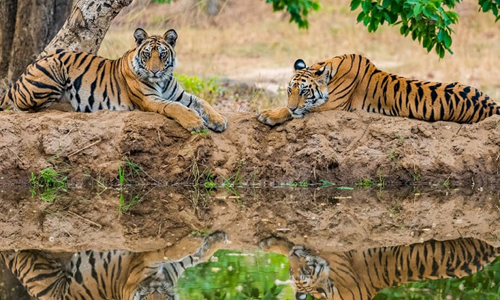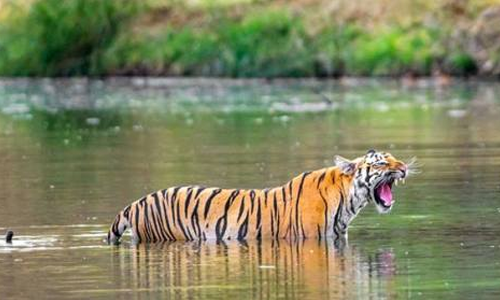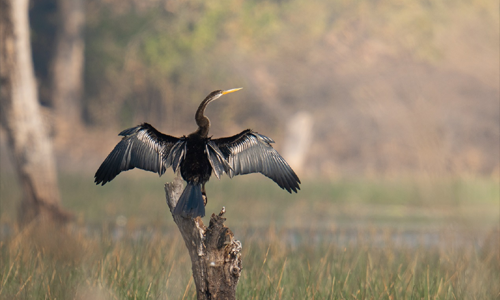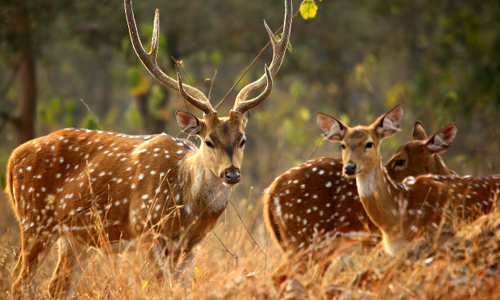Madhya Pradesh, often dubbed the “Heart of India,” boasts a remarkable wealth of forests and diverse wildlife, making it a prime destination for wildlife enthusiasts and photographers alike. Whether you’re on the lookout for the elusive Bengal tiger or hoping to capture the vibrant hues of exotic birds, Madhya Pradesh’s national parks and sanctuaries offer countless opportunities to frame nature in all its glory. In this guide, we’ll delve into some of the state’s top wildlife hotspots, sharing tips to help you elevate your photography skills in these wild settings.
Kanha National Park
 Why Visit
Why Visit
- Tiger Haven: Kanha is famous for its thriving tiger population, as well as other wildlife like the barasingha (swamp deer), leopards, wild dogs, and sloth bears.
- Diverse Landscapes: The park’s mix of meadows, sal forests, and bamboo thickets provides beautiful backdrops and ample photographic variety.
Photography Highlights
- Early Morning Safaris: The soft golden light at dawn not only accentuates the park’s lush landscapes but also increases your chances of spotting tigers and other animals, who are most active during cooler hours.
- Framing Subjects: The tall sal trees and open grasslands lend themselves to creative compositions, allowing you to capture animals in their natural habitat with a blend of textures and colors.
Practical Tips
- Recommended Gear: A telephoto lens (300mm or above) is crucial for close-up shots of elusive wildlife. A mid-range zoom (like 70–200mm) can help capture animals in their environment.
- Best Time to Visit: October to June. Summers (March–June) often yield higher tiger sightings near waterholes.
Bandhavgarh National Park: Land of the Highest Tiger Density
 Why Visit
Why Visit
- Tiger Territory: With one of the highest concentrations of Bengal tigers in the world, Bandhavgarh is the ultimate destination for capturing mesmerizing tiger portraits.
- Rich History: The ancient Bandhavgarh Fort adds historical intrigue, and you can integrate architectural elements into your wildlife shots if you’re fortunate enough to spot animals against the fort’s backdrop.
Photography Highlights
- Safari Zones: The park is divided into multiple zones (Tala, Magadhi, and Khitauli). Tala is known for its scenic beauty and frequent tiger sightings, but the other zones also offer unique photographic opportunities.
- Focus on Eye-Level Shots: Whenever possible, aim your camera from a lower vantage point to achieve an intimate perspective, especially for capturing tigers and leopards.
Practical Tips
- Patience and Persistence: Tigers can be elusive, so be prepared for long waits. Use the downtime to fine-tune camera settings, anticipate animal movements, and experiment with composition.
- Best Time to Visit: October to June, with peak sightings typically in April and May when water sources are scarce.
Pench National Park: Rudyard Kipling’s “The Jungle Book” Setting
 Why Visit
Why Visit
- Inspiration for Literature: Pench’s lush forests and wildlife inspired Rudyard Kipling’s The Jungle Book—an allure for photographers wanting to document the park’s narrative of nature.
- Birdwatcher’s Paradise: Besides tigers, Pench is also home to diverse bird species, making it a double treat for wildlife and avian photography.
Photography Highlights
- Riverine Landscapes: The Pench River cuts through the park, offering chances to capture animals near water, especially during the summer when wildlife congregates around waterholes.
- Diverse Subjects: Apart from tigers and leopards, the park teems with gaur (Indian bison), wild dogs, jackals, and varied birdlife. A flexible zoom lens is handy for shifting between big cats and smaller subjects.
Practical Tips
- Use of Bean Bags / Stable Support: Safaris in Pench often use open-top vehicles; bring a bean bag or monopod to keep your camera steady for sharper images.
- Best Time to Visit: October to June. The monsoon season (July–September) sees the core area closed, though the buffer zone might be accessible.
Satpura Tiger Reserve: A Quiet Haven for Photographers
 Why Visit
Why Visit
- Less Crowded: Satpura is one of the quieter reserves, offering more intimate wildlife encounters without the typical safari rush.
- Unique Safari Options: Boat safaris and walking safaris are available, a rarity in India’s national parks, allowing for varied photographic perspectives.
Photography Highlights
- Boat Safaris: Glide along the Denwa River and photograph animals, like crocodiles and water birds, at eye level—an approach that yields striking images.
- Walking Safaris: If capturing close-up details and ground-level shots is your goal, walking safaris can be invaluable for achieving unique viewpoints of smaller animals, insects, and plant life.
Practical Tips
- Versatile Lenses: Since you can explore on foot, bring macro lenses for capturing insects, flora, and other small wonders you might encounter.
- Best Time to Visit: October to April. Winter months are comfortable for walks, and many bird species migrate to the area.
Panna National Park: Diamonds in the Rough
 Why Visit
Why Visit
- Tiger Reintroduction Success: Panna once faced near extinction of its tiger population but has successfully reintroduced tigers, making it a beacon of conservation triumph.
- Scenic Ken River: The park’s gorge and river offer dramatic backdrops for wildlife photography, with boat safaris providing vantage points similar to Satpura.
Photography Highlights
- Animal Diversity: While tigers are the star attraction, you can also spot leopards, gharials, vultures, and the occasional caracal or wolf if you’re lucky.
- Pandav Falls: Located near the park, this waterfall spot is a picturesque location for landscape shots and a welcome respite from the safari routine.
Practical Tips
- Combine with Khajuraho: Panna is relatively close to the Khajuraho Temples, giving you an opportunity to mix architectural photography with wildlife in one trip.
- Best Time to Visit: November to March for mild weather, though hotter months can lead to higher chances of tiger sightings near rivers.
Nauradehi Wildlife Sanctuary: Off the Beaten Path
 Why Visit
Why Visit
- Less Explored: Nauradehi is an emerging hub for conservation, hosting ambitious reintroduction programs for species like the Indian cheetah.
- Diverse Terrain: Sprawling across grasslands, deciduous forests, and river systems, it provides a variety of habitats and photographic scenes.
Photography Highlights
- Birding Hotspot: Migratory birds flock to Nauradehi’s wetlands, making it perfect for avian photographers seeking rarer species.
- Predator Encounters: Leopards and wolves are among the top predators here, granting ample opportunities for those seeking unique big cat and canid captures.
Practical Tips
- Engage Local Guides: Sanctuary staff often hold deep knowledge of the terrain and animal behaviors. A local guide can significantly enhance your wildlife encounters.
- Best Time to Visit: November to February for comfortable safaris and active birdlife.
Bori Wildlife Sanctuary: Raw and Rugged Wilderness
 Why Visit
Why Visit
- Oldest Forest Reserve: Established in 1865, Bori is part of the Satpura Tiger Reserve. Its untouched landscapes and fewer crowds make it perfect for photographers wanting solitude.
- Diverse Wildlife: Bori’s jungles harbor tigers, leopards, sloth bears, and a multitude of bird species, alongside lesser-known mammals like civets and pangolins.
Photography Highlights
- Untamed Terrain: The rugged terrain and rocky outcrops offer distinctive compositions and a chance to capture animals against dramatic backdrops.
- Remote Explorations: Because Bori remains relatively undeveloped for tourism, you can find truly wild corners for unspoiled photo opportunities.
Practical Tips
- Plan Ahead: Accommodation and safari bookings can be more limited here, so advanced planning is crucial.
- Best Time to Visit: October to June.
Essential Wildlife Photography Tips for Madhya Pradesh
- Gear Selection:
- Telephoto Lens (300mm+): Ideal for distant or elusive wildlife such as tigers and leopards.
- Wide-Angle Lens: Capture landscapes, large herds, or an animal’s environment.
- Macro Lens: Useful for insects, plants, and close-up details.
- Camera Settings & Techniques:
- Fast Shutter Speed: Prevents motion blur when animals move unpredictably.
- Continuous Shooting Mode: Maximizes chances of capturing the perfect moment in action shots.
- Use of Burst Mode & Back-Button Focus: Helps maintain accurate focus on moving subjects.
- Safari Etiquette & Safety:
- Remain Quiet: Minimizing noise ensures you don’t startle or stress the animals.
- Follow Guidelines: Listen to your safari guide for instructions on safe distances and ethical wildlife viewing.
- Time of Day:
- Golden Hours (Sunrise & Sunset): Provides the most beautiful light and higher animal activity.
- Midday: Animals may rest in shade, making sightings less frequent but still possible near waterholes.
- Responsible Photography:
- No Flash: Avoid using flash, which can disturb or stress animals.
- Respect Boundaries: Don’t pressure guides to break park rules for a closer shot. Ethical wildlife photography values animal welfare over personal gain.

Conclusion
Madhya Pradesh’s national parks and wildlife sanctuaries are a paradise for photographers eager to capture India’s magnificent fauna in diverse and often dramatic settings. From tiger-spotting safaris in Bandhavgarh and Kanha to boat rides in Satpura and Panna, each reserve offers unique shooting opportunities. The quieter enclaves like Bori and Nauradehi let you experience raw wilderness with minimal crowds, ensuring your lens focuses only on the splendor of nature.
Whether you’re a seasoned professional or an aspiring photographer looking to explore India’s wild heart, Madhya Pradesh’s forests beckon with promise-vivid colors, majestic creatures, and landscapes bathed in soft sunlight. It’s a visual feast waiting for those willing to rise with the dawn, trek through dense foliage, and patiently wait for those breathtaking, once-in-a-lifetime shots.
WELCOME TO KANHA NATIONAL PARK

